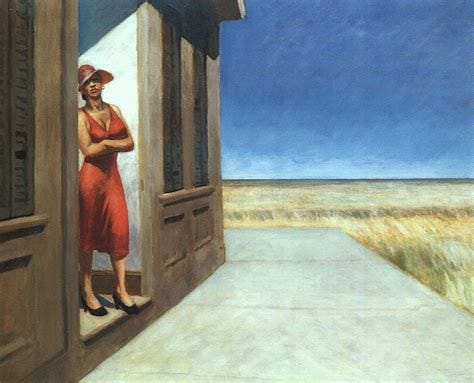The doughy bodies of Edward Hopper & why you need to figure out what you want to paint
Also, resolutions are dumb but I'm offering you one anyway.
A lot of years Rob and I don't celebrate our anniversary. We're busy, we're lazy, we have kids. Sometimes we are in separate states on December 30th. But this year we celebrated 17 years by heading into Manhattan for a glass of wine at Old Homestead and the Edward Hopper show at the Whitney.
The Whitney was bequeathed the Hopper estate and this leads them to put on these large Hopper shows with some frequency. I went to see their last Hopper retrospective with my friend Kirsten who is the daughter of artists and more willing to call it like she sees it as the result of a lifetime of looking at art. “It is just boobs, boobs, boobs,” she said about Hopper’s work.
Yes, it is a lot of boobs. And a lot of exposed thighs. Athletic builds and faces with somewhat masculine-seeming features. And despite the frequency that he painted a lone female into his paintings, I would argue that Hopper is a little clumsy when painting the body. In fact, I would argue that his female subjects display a lack of interest on the part of the artist in regards to painting a human figure.
“They’re pretty doughy,” Rob said as we discussed the bodies of these women. I knew what he meant. Like they didn’t feel like they were made of human flesh, they felt clumped up, like Hopper had thrown dough at them. This made the bodies feel somewhat un-lifelike, like how a clothing store mannequin always appears lifeless, even from far away. They are stiff and unnatural. The shapes are also disproportionate and slightly exaggerated, a more mild version of a R. Crumb woman.
To me it feels like Hopper didn’t love painting the human body. And maybe he didn’t want to paint them. Maybe he wanted to instead only paint the architecture, a city scene and that interiors that to me are the pieces of his paintings that demonstrate his genius. After all, shis is artist who said, “All I really want to do is paint light on the side of a house.”
Look at his paintings of space and light and you see that Hopper spent a lot of time on the scenes out the windows, the light on a sheet, the shape of light on a floor. It is obvious that shape, rooms, views excite him. I don’t know that he liked painting the people he felt compelled to insert in the room. Or maybe had felt like he had to insert a human being in the room in order to give us the sense of loneliness that is the touchstone of his work. The bodies seem like an afterthought.
Your lesson as an artist in that you must figure out what you want to be painting and paint that. You need to pay attention to where you lose time as you work, where you get lost in details and what you repeatedly get frustrated when attempting to paint. I would argue that your best work will emerge when you are fully engrossed in some subject matter or painting challenge and it will be weak when you are forcing yourself to paint or explore something you don’t really care to spend time with.
WHO NEEDS A MUSE? My 2023 resolution is to to use this newsletter to help you create more paintings. So I’ve added a section to my newsletter for 2023 called WHO NEEDS A MUSE? that will offer a prompt to help all of you painters out there fight off any painter’s block you might experience.
PROMPT: Look through your high school photos or a high school yearbook and give yourself only one minute to flip through, looking for something to paint. Would you like to paint a still life of a table full of red Solo cups and cans of beer for a game of beer pong? Would you like to do a portrait of your best friend with her hair done up for prom? Maybe you would like to paint the outside of the building itself. Or would you like to paint the alto saxophone that kept you sane in an otherwise emotionally stressful period of your life? And take note of what you were drawn to in that collection of images form your past, the more often you do that, the more likely you will find you own light on the wall.






